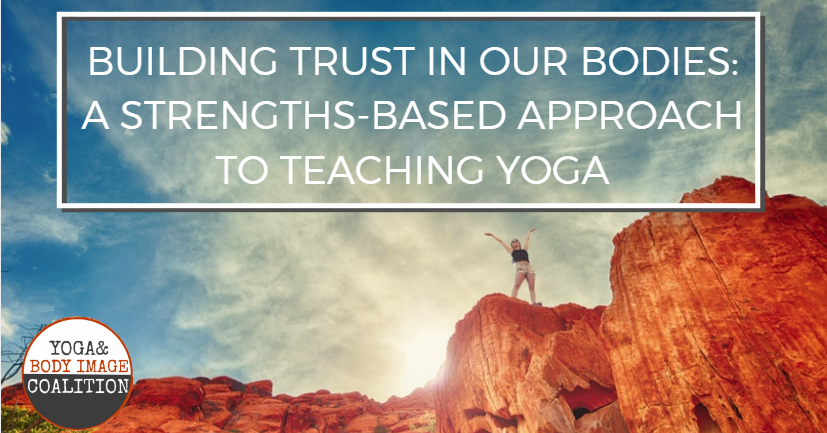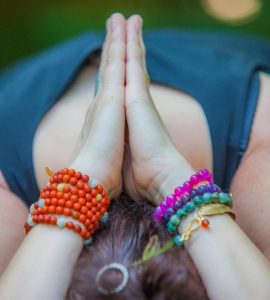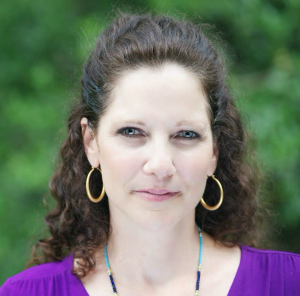Building Trust in Our Bodies: A Strengths-Based Approach to Teaching Yoga
August 2, 2016
The following is a guest post by Yoga and Body Image Coalition partner, Gwen Soffer.
If I were to sum up what practicing yoga has taught me the most, it would be learning to trust my own being. In my younger years, I never considered trusting my body. My body was usually something I fought against whether it was my weight, my height, my emotions, or my abilities. It did not represent personal power but rather personal struggle. My focus was on the lack and what I wanted my body to be, look like or perform not on the abundance and knowledge it innately had to offer me.
Yoga was initially just another way for me to shape my body into a form I thought acceptable or to prove that I was agile, graceful, or skilled enough to even practice and teach yoga at all. Honestly, I am not sure what came first, my changing attitude about my yoga practice and teaching or my understanding and trust of my own body. In most likelihood, the two happened at the same time, a true yoking.
As I built this trust, something interesting started to happen—I felt powerful and my boundaries got very clear. I no longer wanted anyone to tell me how my body should look or what it should be able to do. This changed my relationship to yoga completely. I had taken ownership of my body and my practice, and I no longer wanted to be in a situation where a teacher took the attitude that they knew my body better than I did.

With this trust in my body and shift in my yoga practice, I started to teach from a strengths-based perspective. A strengths-based approach is a practice theory used in service professions such as social work and education that focuses on inherent individual strengths and capabilities with its foundation based in empowerment and self-determination (Saleebey, 1996). This approach was developed in response to the more traditional and opposing deficit-based perspective that has its focus on experts fixing others without regard to the unique, resourceful and resilient nature of the individual experience. Dennis Saleeby (2008), a pioneer of the strengths-based approach, explains that this is a “conceptual and practical lens through which to see the work you do” where the focus is “not about problem solving but possibility making”.
Consider all the ways that a typical yoga class could be deficit-based because of the common way it is taught: the teacher is positioned as the absolute authority (and often represents the “acceptable” yoga body) and gives commanding instruction and correction (that often imply compliance and uniformity) or even physically manipulates your body with physical assists/adjustments (often without asking permission to do so and in invasive and potentially harmful ways).
Of course, part of our role as yoga teachers is to share our knowledge, keep students safe, and offer instruction on the poses. What I am questioning is the why we teach the way we do and how we can better serve our students as individuals. Teachers often assert their expertise based on their own experience and assumptions without the consideration of the individual’s unique needs or personal preference. This approach potentially robs students of the empowering opportunity to determine what feels right in their own body and sets the student up for feeling as if they are not enough.
Strengths-Based Model and Yoga
There are some key components of a strength-based model that are directly applicable to teaching yoga and are more consistent with promoting trust in our own bodies as opposed to reinforcing perceived deficits.
1. Student-Driven vs. Teacher Dictated
One of the main differences between the two approaches is that strengths-based teaching is student-driven and deficit-based is teacher-dictated. The first step to trusting our own being is to believe that we are the experts of ourselves. As yoga teachers, we can work from this guiding principle and look for ways to empower our students instead of working from a place of implied deficit, which disempowers the student and puts all of the power with the authority.
Our knowledge is valuable and is the reason students show up to our classes, but this expertise does not make us the expert of another’s body or experience. With this understanding, we take the role of experienced guides rather than absolute authorities. Saleebey (1992b) describes this attitude as:
A give-and-take that begins with the demystification of the professional as expert, an operating sense of humility on the part of the helper, the establishment of an egalitarian transaction, the desire to engage clients on their own terms, and a willingness to disclose and share. (p.42)
2. Student as Expert
Although students may be inexperienced at yoga, they are the experts of their own bodies and experience. I have  many memories of being in classes, often at yoga conferences, when teachers or assistants came up to me to offer an assist (never asking permission) to “get me to go deeper,” at least one time causing a serious injury. This would happen in classes where the teacher knew nothing about me and took no personal choice or preference about how I was expressing the pose into consideration. This left me feeling like the experience of my pose was public property. These interactions seemed to be more about building the teacher and assistant’s self-confidence about their teaching skills rather than enhancing my practice. Some of the assists were downright irrational, as if the more bizarre and elaborate the assist the better. I can only conclude that this had nothing to do with me and had everything to do with how the teachers wanted to be perceived.
many memories of being in classes, often at yoga conferences, when teachers or assistants came up to me to offer an assist (never asking permission) to “get me to go deeper,” at least one time causing a serious injury. This would happen in classes where the teacher knew nothing about me and took no personal choice or preference about how I was expressing the pose into consideration. This left me feeling like the experience of my pose was public property. These interactions seemed to be more about building the teacher and assistant’s self-confidence about their teaching skills rather than enhancing my practice. Some of the assists were downright irrational, as if the more bizarre and elaborate the assist the better. I can only conclude that this had nothing to do with me and had everything to do with how the teachers wanted to be perceived.
We cannot know what a student is experiencing, and there are so many reasons someone may choice to be in the pose differently than we instruct. What it comes down to is keeping our assumptions and expectations of students in check so that when we do offer an adjustment or assist it is specific to that individual and is to promote safety not our own egos. Stepping out of the role as fixer gives students the opportunity to build confidence in their own bodies.
3. Students do not Need to be Fixed
We are often taught that our role is to fix our students by pointing out all of the things they are doing “wrong” or all of the ways they could be doing it “better”. How often do we as teachers offer an assist or adjustment because it validates us as teachers, and we are trying to prove that we know more than our students, or even more than other teachers? A constant focus on second-guessing students creates an environment of deficit and undermines students self-determining what feels right in their own body.
4. Teacher as Collaborator not Authority
A core element of the strength-based perspective is reducing the imbalance of the power relationship between teacher and student by starting with the belief that the student is the expert of their life (and body). With any teacher/student relationship there is an uneven power dynamic that cannot be denied or completely abolished, but there are conscious steps we can take to minimize this.
There is a fine line between sharing knowledge and presenting as the authority, but the differentiating factor is our attitude. Another aspect of moving away from a deficit-based approach is reducing the power differential of student and teacher not only by identifying the student as expert but also minimizing the student’s reliance on the teacher for having all of the answers. A relationship based on dependence is never empowering.
Even well-meaning service providers are too quick to impose their own views of the world upon their clients. The professional’s investment in, and emotional attachment to, their own theory of helping leads them to believe they know what’s best. This tendency [excludes] the client from …the process…(Poertner & Ronnau, 1992, p. 117)
5. Creating Safe Spaces for Experiential Growth
A constant focus on deficit and correction can be problematic because one, it creates an environment where the student is constantly trying to please the teacher, and two, it undermines the students’ understanding of their inherent strengths as well as boundaries. The safety of the space is maintained by our attitude, our self-awareness as well as by the language and teaching techniques we use.
For this reason, as well as the trauma-informed lens that I wear always, I am very careful when and how I cue and offer assists and adjustments. First, I always ask students to place a Permission Stone (a technique I use to indicate that there is consent for touch). Even with the Permission Stone, however, I like to offer the student the opportunity to self-correct without interjecting my touch. I have had to get really good at verbal cueing as well as demonstration so that my class has the opportunity to make the suggested change themselves based on how it feels in their body.  This approach allows students to experience the yoga pose in their body without the added distraction of trying to please a teacher or live up to a pre-conceived standard.
This approach allows students to experience the yoga pose in their body without the added distraction of trying to please a teacher or live up to a pre-conceived standard.
6. Giving Choice and Control to the Student
There is more than one way to do things and poses are experienced in many ways. Once I understood this, I started to offer non-hierarchical options to poses, not making assumptions about how the pose feels for people and what it should do for them. I no longer offer savasana, for example, as the only choice at the end of the practice, but ask students to choice any resting pose they like. These kinds of choices create an atmosphere where the student is an active participant instead of passive receiver and gives the student the opportunity to create the pose that supports their individualized experience.
What is Our Role?
A strengths-based approach is a paradigm that can offer us a reference point for our yoga teaching and a self-check mechanism for keeping our focus on building confidence, resiliency, agency and body trust in our students. I have experienced the benefit of yoga in a group setting many times when that circle is safe, the leader is self-aware, in tune with the needs of others, and when there is no expectation of what will or will not happen. I have also been in classes where I did not feel safe, and my experience was negated by the need of the teacher to be center stage. A strengths-based approach is a model that can help us structure a safe space for our students to connect and develop trust with themselves and feel empowered to be who they are not who they think we want them to be.
About Gwen

Gwen Soffer is a trauma-informed yoga teacher, women’s self-defense instructor, author, and community mentor. She is co-founder of Enso studio in Media, Pa. and leads trauma-sensitive yoga classes for survivors of trauma. She believes in the strength of the human spirit and is committed to creating safe and empowering spaces for her students to heal. www.experienceenso.com
References
Poertner, J. and Ronnau, J. (1992). A strengths approach to children with emotional disabilities. In Saleebey, D. (Ed.), The strengths perspective in social work practice. New York: Longman.
Saleebey, D. (1992b). The strengths perspective in social work practice. New York: Longman.
Saleebey, D. (1996). The strengths perspective in social work practice: extensions and cautions. Social Work, 41(3), 296–305.
Saleebey, D. (2008). Commentary on the strengths perspective and potential applications in school counseling. Professional School Counseling, 12(2), 68–75.
